I attended an extremely interesting webinar yesterday. The webinar was an introduction to Biomimicry for architects, designers, planners, developers, and the list goes on. And while I have a bit of an understanding of what Biomimicry is, since I am a Planner with a geography and zoology background, many others in the Building Science field do not know anything about the concept. And in the face of an exponentially growing population; an increase in the need for sustainable development and resilience (all thanks to climate change), it is becoming more and more important for Building Science to look at alternative ways of practice.
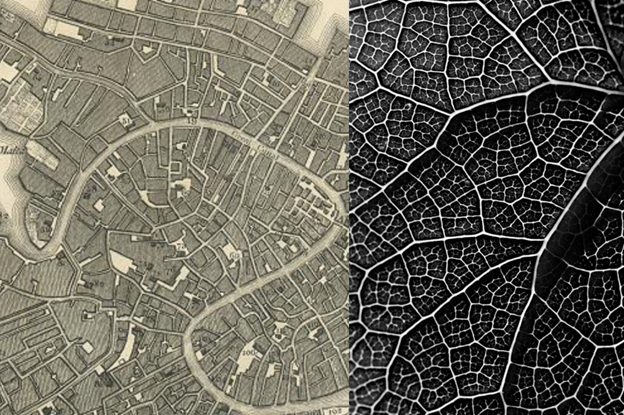
Street layouts mimic the veins of leaves.
Source: https://thrive-collaborative.com/blog/tag/biomimicry
What is Biomimicry?
Let’s break down the word into BIO and MIMIC. Bio refers to natural happenings in our ecosystems. Mimic refers to copying. So in short Biomimicry is the imitation of nature. The Biomimicry Institute defined the concept as follows: “an approach to innovation that seeks sustainable solutions to human challenges by emulating nature’s time-tested patterns and strategies. The goal is to create products, processes, and policies—new ways of living—that are well-adapted to life on earth over the long haul.” In other words, people are able to learn and imitate processes, adaptions and ecosystems that we find in nature, in order to develop more sustainable designs. The aim is to take inspiration from nature and translate these processes and adaptions into principles we can use in the Building Science field.
How does Building Science make use of Biomimicry?
When we look at nature and the evolutionary happenings, it is clear that nature has adapted over the years and figured out what works best. If you think about it nature has already dealt with the challenges, we as a society face and struggle to fix. On top of that, the animal kingdom has adapted to current-day change as well. It all traces back to survival of the fittest. The ones who adapt quick enough and well enough survive. Society needs to start adapting…
Biomimicry makes use of technology to research and implement lessons from nature into building and development practices. The concept is divided into three categories:
The model. First natural models need to be studied and understood. Afterwards, it can be implemented or used as inspiration for new designs or processes found in society.
A measure of ecological standards, that allows us to evaluate human activities. We are able to compare human activities to natural ones and determine how adaptive and resilient they are.
It is sort of like a mentor. We are constantly guided by nature. Animals are able to warn people about earthquakes or eruptions’ before we even notice anything is wrong. Biomimicry is a new way for society to value nature, pay attention and learn.
Examples of Biomimicry
The Wright brothers took inspiration from flying pigeons, making it possible for humans to soar above the clouds.
The famous Japanese Bullet train was inspired by the shape of a bird’s beak.
In cities with very high buildings, birds tend to fly into windows resulting in a decrease in bird populations. Architects and designers have taken inspiration from spiders, to create safer windows. And yes I get how crazy that sounds. In nature, spiders tend to build webs between tree brunches, and one can easily walk into in. But birds are able to see the webs. This is possible since spiders weave UV reflective strands into their webs, while it is invisible to humans and birds are able to see it. The principle has been carried over into the human world with designers creating classes with UV strands in them.
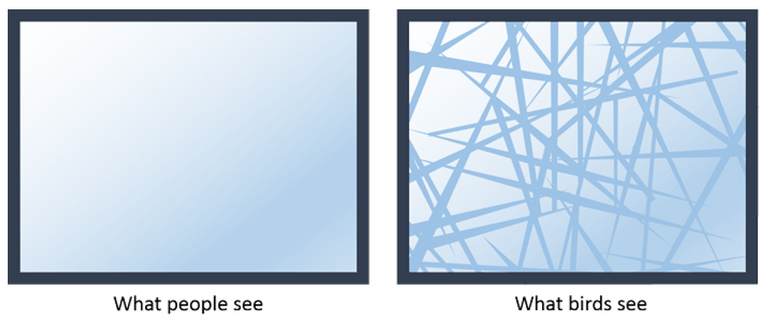
This is an extremely interesting concept!
Source: https://gtac.edu.au/spiderweb-glass-in-the-news/
Plastic has become a part of everyday life, but it leads to a lot of waste. By studying nature, companies such as Novomer have changed the plastic game. In nature, Carbon dioxide is a feedstock used in materials-production processes like photosynthesis. Novomer has produced high-performance organic chemicals at a low cost that are used to create sustainable foams and plastics.
Building designs have been inspired by termite mounds to design passive cooling structures. Urban areas are made up of building that consumes 40% of all used energy. Mick Pearce designed the Eastgate Building, in Zimbabwe which uses 90% less energy and relies on natural ventilation. It is modelled on the self-cooling mounds of termites. Termites have adapted and found ways to maintain the temperature inside their mounds while the temperatures outside swing from 42 °C to 3 °C.
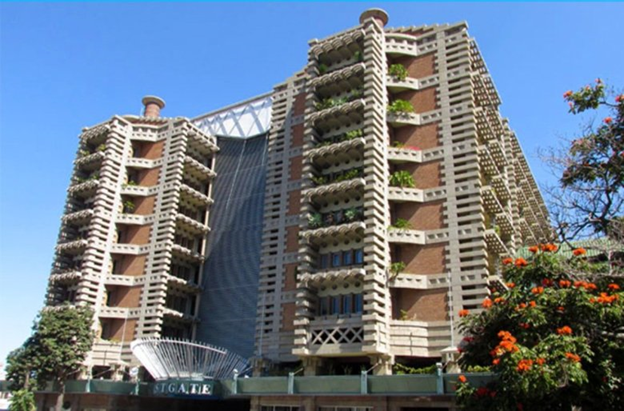
Eastgate Building, in Zimbabwe. The building mimics the tunnels and flow of termite mounds that help to regulate the temperature. There is absolutely no air conditioning in this building.
Source: https://earthbound.report/2020/05/15/building-of-the-week-eastgate-zimbabwe/

Source: https://parametrichouse.com/biomimicry-architecture-2/
Industrial Ecology refers to industrial systems that follow a closed model or circular economy. Everything within the system is reused and recycled to ensure no waste is produced. By-products of one industry serve as the raw materials of another industry. Examples include Sasolburg Eco-industrial Park in South Africa, Kalundborg Eco-Industrial Park in Denmark, Burnside Park in Nova Scotia, etc.
Designers have also learned how to create efficient wind power from whales. Wind tunnel tests of model humpback fins with and without tubercles have demonstrated the aerodynamic improvements tubercles make. These lessons have been used to design wind turbines with increased efficiency and have the potential to improve the performance of planes.
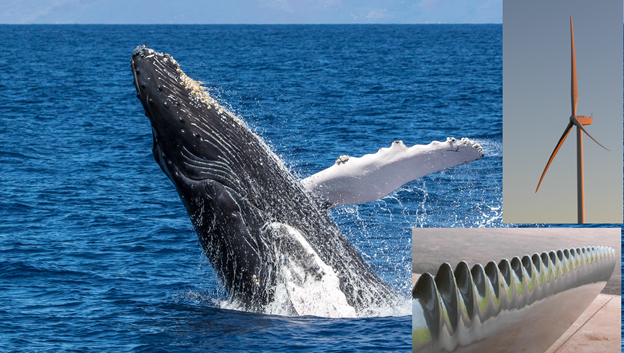
The shape of wind turbines takes inspiration from whale fins.
Source: thttps://ideas4development.org/en/biomimicry-reconciling-humanity-with-biodiversity/
- A company called bioMASON grows bricks in greenhouse-like conditions. Yes, you read that correct… They grow bricks. The process uses bacteria that alter the pH balance of the surrounding aggregate material, allowing calcium carbonate to grow and bind the material together with little to no carbon emissions. This is a mimicry of coral reefs. The best part is that these bricks glow, and can be used on sidewalks for safety.

bioMASON brick that glows at night. The process takes inspiration from coral reefs.
Source: https://redshift.autodesk.com/articles/biomimicry-in-architecture
How does biomimicry contribute to sustainable development?
If designers, engineers, business leaders, architects, and other innovators start to follow Biomimicry, it will give way to more efficient, sustainable and resilient production. Humans have a lot to learn from nature, seeing that we have not been a part of this world for nearly as long as other species. Nature has adapted over hundred and thousands of years, finding the best ways to survive, adapting in short time frames and outliving those not able to. Natural environments and ecosystems have become resilient and sustainable (unfortunately society has been destroying it). If we are able to shift the way, we design and develop and focus on mimicking nature we can develop more sustainably and society will become more resilient to natural changes.
Sources
Please note that I make use of various articles to form my posts. All articles used are listed below. Feel free to download and read them!
https://youmatter.world/en/definition/definitions-what-is-biomimicry-definition-examples/
https://www.smithsonianmag.com/science-nature/how-biomimicry-is-inspiring-human-innovation-17924040/
https://redshift.autodesk.com/articles/biomimicry-in-architecture

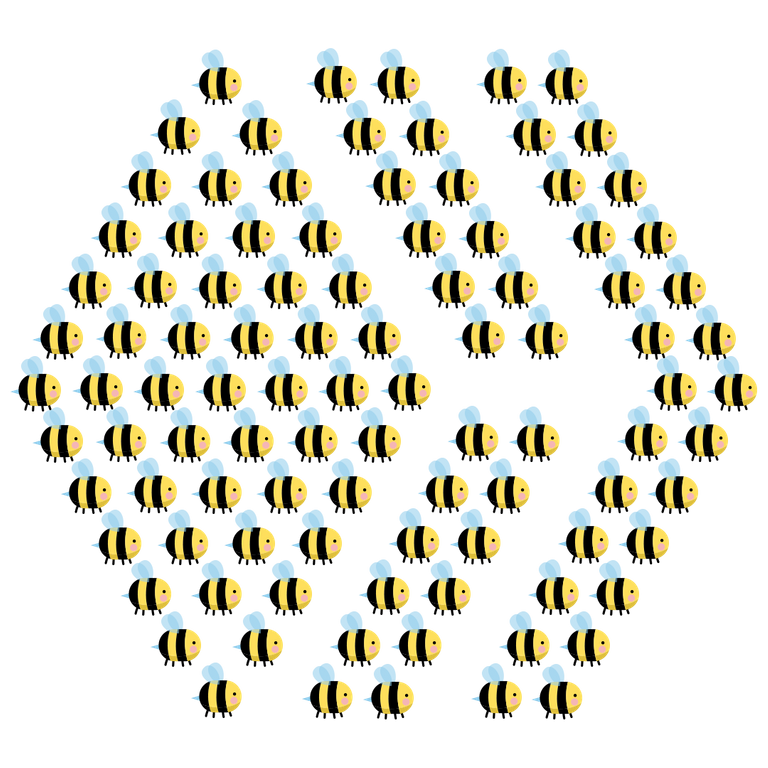
Hive Bee Logo by @doze
Very interesting article. Thanks for sharing! !LUV
(1/1) gave you LUV. tools | wallet | discord | community | <>< daily
tools | wallet | discord | community | <>< daily
HiveBuzz.me NFT for Peace
This interests me a lot. And I really biomimicry would help our environment. Making a more sustainable designs
Hi @misshugo ! Thanks for sharing this very interesting and informative article :)
I didn’t really took the time to welcoming you here after I read your introduction that I enjoyed a lot, so I’m doing here ☺️
Maybe I can advice you that to not use too much the cross-posting or at least in the right communities... I know that for OCD for example it’s not super/always relevant :) Seek for right place, as for this post, there’s Science related community... For me it’s not a problem, but I know other users would see it from an other point of view..
I wish you to have a nice journey here on HIVE ! May your weekend be pleasant 🍀
Hello! And thank you, I didn't even think about looking for a science community 😱. I tried research and couldn't find anything. I'll have a look into it. I'm also still trying to figure the communities out, I end up only posting in my blog, having to go back and post in a community. Thank you for informing me. I really hope to contribute something bigger to the platform in the future.
Hi !
You're very welcome :) I found this one which is really nice : https://peakd.com/c/hive-163521/created !
It's normal to search a bit at the beginning, four years I'm here and still don't understand everything hehe ! Don't hesitate to ask if you need :)
That's nice but don't put yourself under pressure, Hive is a long run, more a marathon than a sprint... Less competitive in my spirit ^^
Really looking forward for yours future articles :)
Yay! 🤗
Your content has been boosted with Ecency Points
Use Ecency daily to boost your growth on platform!
Support Ecency
Vote for new Proposal
Delegate HP and earn more, by @misshugo.
Wow 😳 I didn't even hear about biomimicry till now. Thanks for sharing about that webinar
How interesting! very good post
As the world becomes increasingly complex, we are looking to nature for answers. The field of biomimicry studies how we can use nature's design principles to solve some of humanity's most pressing challenges.
Biomimicry is not only an important tool for sustainable design, but it also has the potential to help us build a more resilient world. By studying and copying nature's design solutions, we can create systems that are better equipped to withstand the challenges of a changing world.